
Supplementary material corresponding to Wallace and Grommet: A close shave.
- Subject:
- Physical Science
- Material Type:
- Homework/Assignment
- Date Added:
- 06/01/2017

Supplementary material corresponding to Wallace and Grommet: A close shave.
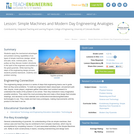
Students apply the mechanical advantages and problem-solving capabilities of six types of simple machines (wedge, wheel and axle, lever, inclined plane, screw, pulley) as they discuss modern structures in the spirit of the engineers and builders of the great pyramids. While learning the steps of the engineering design process, students practice teamwork, creativity and problem solving.
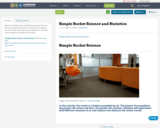
Students will determine whether the amount of air in a balloon changes the distance it will travel on a fishing line. They will collect data from multiple tests and then create a graph to visualize the variation.

In this activity, learners create a tiny electric, motorized dancer. Learners use the interactions of magnetism and electric current to make a wire spin, while displaying the Lorentz Force in action. This lesson guide provides one of many ways to build the spinner and links to other methods.
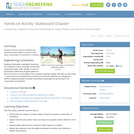
Students examine collisions between two skateboards with different masses to learn about conservation of momentum in collisions.

Skyscrapers are one of the most glorified products of Civil Engineering and contain an interesting history of progress and development. In this lesson, the students will learn about the history of the world's tallest free standing structures and the basic design principles behind their success. Students will build their own newspaper skyscrapers with limited materials and time, trying to achieve a maximum height and the ability to withstand a "hurricane wind" force. Discussion will concentrate on materials, forces that a skyscraper needs to withstand, and basic structural design.
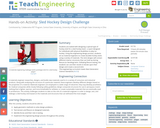
Students are tasked with designing a special type of hockey stick for a sled hockey team—a sport designed for individuals with physical disabilities to play ice hockey. Using the engineering design process, students act as material engineers to create durable hockey sticks using a variety of materials. The stick designs will contain different interior structures that can hold up during flexure (or bending) tests. Following flexure testing, the students can use their results to iterate upon their design and create a second stick.
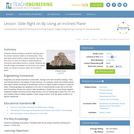
Students explore building a pyramid, learning about the simple machine called an inclined plane. They also learn about another simple machine, the screw, and how it is used as a lifting or fastening device. During a hands-on activity, students see how the angle of inclination and pull force can make it easier (or harder) to pull an object up an inclined plane.
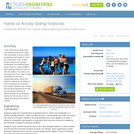
In the culminating activity of the unit, students explore and apply their knowledge of forces, friction, acceleration and gravity in a two-part experiment. First, student groups measure the average acceleration of a textbook pulled along a table by varying weights (with optional extensions, such as with the addition of a pulley or an inclined plane). Then, with a simple modification to the same experimental setup, teams test different surfaces for the effects of friction, graphing and analyzing their results. Students also consider the real-world applications for high- and low-friction surfaces for different situations and purposes, seeing how forces play a role in engineering design and material choices.
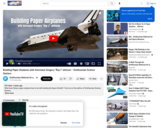
What does flying a paper airplane have to do with landing the Space Shuttle?
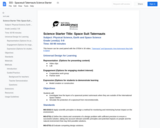
In this lesson students investigate how the layers of a spacesuit protect an astronaut in space.
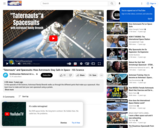
Astronaut Randy Bresnik walks us through the different parts that make up a spacesuit. Also learn how to make and test your own spacesuit using a potato.

Working as if they were engineers, students design and construct model solar sails made of aluminum foil to move cardboard tube satellites through “space” on a string. Working in teams, they follow the engineering design thinking steps—empathize, define, ideate, prototype, test, redesign—to design and test small-scale solar sails for satellites and space probes. During the process, learn about Newton’s laws of motion and the transfer of energy from wave energy to mechanical energy. A student activity worksheet is provided.
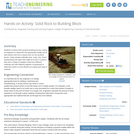
Students continue their pyramid building journey, acting as engineers to determine the appropriate wedge tool to best extract rock from a quarry and cut into pyramid blocks. Using sample materials (wax, soap, clay, foam) representing rock types that might be found in a quarry, they test a variety of wedges made from different materials and with different degrees of sharpness to determine which is most effective at cutting each type of material.
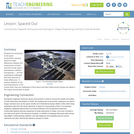
This lesson introduces students to the space environment. It covers the major differences between the environment on Earth and that of outer space and the engineering challenges that arise because of these discrepancies. In order to prepare students for the upcoming lessons on the human body, this lesson challenges them to think about how their bodies would change and adapt in the unique environment of space.
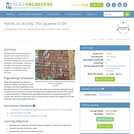
Through hands-on group projects, students learn about the force of compression and how it acts on structural components. Using everyday materials, such as paper, toothpicks and tape, they construct structures designed to (hopefully) support the weight of a cinder block for 30 seconds.
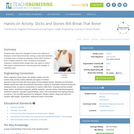
Students learn about the strength of bones and methods of helping to mend fractured bones. During a class demonstration, a chicken bone is broken by applying a load until it reaches a point of failure (fracture). Then, working as biomedical engineers, students teams design their own splint or cast to help repair a fractured bone, learning about the strength of materials used.
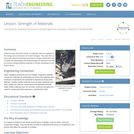
Students learn about the variety of materials used by engineers in the design and construction of modern bridges. They also find out about the material properties important to bridge construction and consider the advantages and disadvantages of steel and concrete as common bridge-building materials to handle compressive and tensile forces.

Students learn about contact stress and its applications in engineering. They are introduced to the concept of heavy loads, such as buildings, elephants, people and traffic, and learn how those heavy loads apply contact stress. Through the analysis of their own footprints, students determine their contact stress.
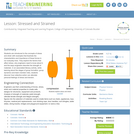
Students are introduced to the concepts of stress and strain with examples that illustrate the characteristics and importance of these forces in our everyday lives. They explore the factors that affect stress, why engineers need to know about it, and the ways engineers describe the strength of materials. In an associated literacy activity, while learning about the stages of group formation, group dynamics and team member roles, students discover how collective action can alleviate personal feelings of stress and tension.